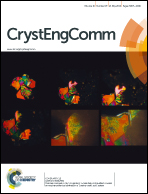Construction of three pH-dependent luminescent metal–organic frameworks with 3-(4-carboxyphen-yl)-1,3-benzoimidazole†
Abstract
Three luminescent metal–organic frameworks (MOFs) with 3-(4-carboxyphenyl)-1,3-benzoimidazole (HCPBm), named [Er(CPBm)3]n (1), [Zn(CPBm)2]n (2) and {Zn[Er(CPBm)(OH)(H2O)4]4·(ClO4)4·Cl2}n (3), have been synthesized using zinc(II) chloride, erbium(III) perchlorate and the ligand HCPBm under different pH conditions. Complex 1 obtained at pH = 5.5 exhibits a 1-D chain structure based on Er(III). At pH = 7.0, a 2-D Zn(II)-based layer 2 forms. The reaction at pH = 8.5 leads to a 2-D heteronuclear square grid layer 3 with a rare stacking fashion of ⋯ABCD⋯ in a 3-D supramolecular network. Compound 1 shows typical lanthanide Er(III) near-infrared emission, and compound 2 has strong fluorescent emission based on the ligand HCPBm. However, compound 3 presents sensitized near-infrared emission (λmax = 1500 nm) upon excitation of the Zn(II) unit in the visible region (400 nm) due to efficient energy transfer from the Zn(II) ion to the Er(III) units.


 Please wait while we load your content...
Please wait while we load your content...